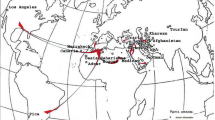Abstract
This article evaluates the vitality of the ancient karez systems in various aspects in modern society by providing examples from Turpan region of China. These aspects include the historical and cultural importance, socio-economic impacts, interactions with the surrounding environment, contribution to agricultural biodiversity in arid lands, and unique regional characteristics of karezes. The results show that the karez systems are not only economically feasible but also a sustainable water supply for irrigation and domestic uses. Furthermore, karezes have invaluable historical, cultural, and social significance. However, karez systems are facing abandonment due to the introduction of new technologies as a result of an increase in water demand. Karezes are particularly susceptible to impairment by groundwater withdrawals with modern wells and pumps. In such regions, the proper conservation and maintenance of karez systems will help sustainable water management and contribute to economic development.




Similar content being viewed by others
References
Beaumont P (1989) The karez: a means of water provision from groundwater sources. In: Beaumont P, Bonine ME, McLachlan K (eds) Karez, Kariz and Khattara: traditional water systems in the Middle East and North Africa. Whitstable Litho Ltd., Cambridgeshire, pp 13–31
Bonine ME (1989) Karezes, field systems, and morphology: retangularity on the Iranian Plateau. In: Beaumont P, Bonine ME, McLachlan K (eds) Karez, Kariz and Khattara: traditional water systems in the Middle East and North Africa. Whitstable Litho Ltd., Cambridgeshire, pp 35–57
Centre for Sustainable Development (Cenesta) (2003) Karez irrigation systems: an Ancient Water Distribution System allowing specialized and diverse cropping in desert regions of Iran. DIALOG, www.cenesta.org/projects/karez/Karez%20Irrigation%20Systems.doc. Accessed 12 Dec 2008
English PW (1998) Karezes and lifeworlds in Iranian plateau villages. Yale For Environ Sci Bull 103:187–205
Guan DH, Zhang SJ, Nuridin G (2005) Analysis on the current status and prevention strategies for karez systems in Xinjiang. Xinjiang Water Res. 3:1–3
Haakon L, Shen Y (2006) The disappearance of the karez of Turpan. Report from the project ‘Harvest from wasteland. Land, people and water management reforms in the dry lands of Xinjiang’. Acta Geographica Series A 15. Department of Geography, Norwegian University of Science and Technology (NTNU), Trondheim
Haeri MR (2003) Kariz (Karez): AN eternal friendly system for harvesting groundwater. DIALOG, http://unfccc.int/files/meetings/workshops/other_meetings/application/pdf/121103_iran.pdf. Accessed 3 Feb 2007
Hansen RD (1999) Karez (Qanats) of Turpan, China. DIALOG, www.waterhistory.org/histories/turpan/turpan.pdf. Accessed 16 Nov 2007
Hitch D (2009) The special status of Turpan. In Victor HM (ed) Sino-Platonic Papers No. 186. Department of East Asian Languages and Civilizations, University of Pennsylvania Philadelphia, pp 8–9
Huntington E (1907) The depression of Turpan, in Central Asia. Geogr J 30:254–273
International Center on Karezes and Historic Hydraulic Structures (ICQHS) (2008) History of karezes. DIALOG, http://www.karez.info/en/history.php. Accessed 24 Mar 2008
Lambton AKS (1989) The origin, diffusion and functioning of the karez. In: Beaumont P, Bonine ME, McLachlan K (eds) Karez, Kariz and Khattara: traditional water systems in the Middle East and North Africa. Whitstable Litho Ltd., Cambridgeshire, pp 5–12
Lightfoot DR (1996) Syrian karez romani: history, ecology, abandonment. J. Arid. Environ. 33:321–336
Nuridin G (2008) Underground water project in Xinjiang–karez systems. Xinjiang People’s Press, Urumqi
Peoples’ Republic of China National Standard (1985) China sanitary standard for drinking water (GB5749-1985), UDC 613.3
Sun Q, Wang T, Kobori I, Liang L (2009) Karez in the Turpan region of China. In: Bigas H, Adeel Z, Schuster B (eds) Seeing traditional technologies in a new light—using traditional approaches for water management in drylands. United Nations University International Network on Water, Environment and Health (UNU-INWEH), pp 12–14
Todd DK (1980) Groundwater hydrology, 2nd edn. Wiley, New York
Wessels J, Hoogeveen RJA (2002) Renovation of karezes in Syria. Sustainable management of marginal drylands, application of indigenous knowledge for coastal drylands. In: Proceedings of a joint UNU-UNESCO-ICARDA international workshop, Alexandria, Egypt, ISBN 92-808-8011-X, pp 1–13
Xinhua News Agency (2004) Ancient irrigation system may disappear in 25 years. DIALOG, http://www.china.org.cn/english/2004/Dec/115427.htm. Accessed 18 Oct 2005
Xinjiang Uyghur Autonomous Region Statistics Bureau (1997) Social and economic development in district, prefecture, city, and county in Xinjiang. Xinjiang People’s Press, Urumqi
Author information
Authors and Affiliations
Corresponding author
Rights and permissions
About this article
Cite this article
Abudu, S., Cevik, S.Y., Bawazir, S. et al. Vitality of ancient karez systems in arid lands: a case study in Turpan region of China. Water Hist 3, 213–225 (2011). https://doi.org/10.1007/s12685-011-0044-5
Received:
Accepted:
Published:
Issue Date:
DOI: https://doi.org/10.1007/s12685-011-0044-5




